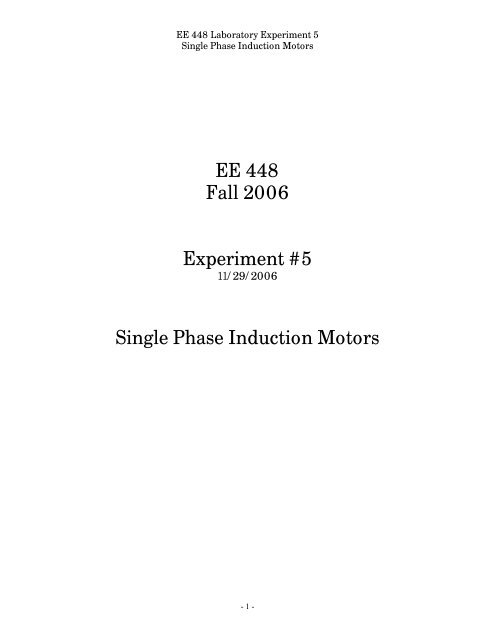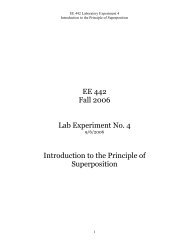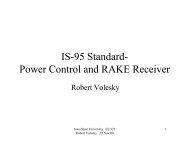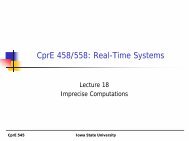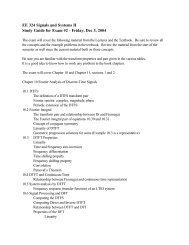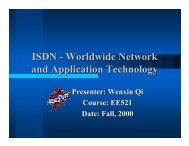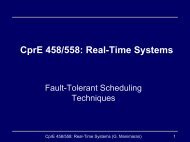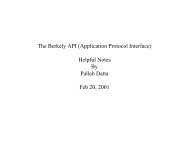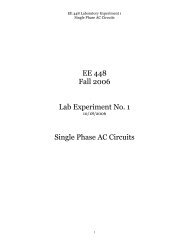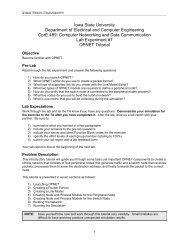Lab Experiment No. 5: Single-Phase Motors
Lab Experiment No. 5: Single-Phase Motors
Lab Experiment No. 5: Single-Phase Motors
- No tags were found...
You also want an ePaper? Increase the reach of your titles
YUMPU automatically turns print PDFs into web optimized ePapers that Google loves.
EE 448 <strong>Lab</strong>oratory <strong>Experiment</strong> 5<strong>Single</strong> <strong>Phase</strong> Induction <strong>Motors</strong>EE 448Fall 2006<strong>Experiment</strong> #511/29/2006<strong>Single</strong> <strong>Phase</strong> Induction <strong>Motors</strong>- 1 -
EE 448 <strong>Lab</strong>oratory <strong>Experiment</strong> 5<strong>Single</strong> <strong>Phase</strong> Induction <strong>Motors</strong>I. INTRODUCTIONOBJECTIVES:1. To examine the construction of the capacitor- run and the capacitor -start motors.2. To determine their starting and running characteristics.3. To compare their starting and running performance with each other.BACKGROUND SUMMARY<strong>Single</strong>-phase motors are all rather noisy because they vibrate at 120 Hzwhen operated on- a 60 Hz power line. Various attempts to reduce thisnoise, such as resilient rubber mounting, are never totally effective ineliminating this vibration, particularly when the motor is directly coupledto a large resonant-prone fan.The capacitor run motor is very useful in this type of application becausethe motor can be designed to have low vibration under full-load. Thecapacitor serves to shift the phase on one of the windings so that thecurrent through the winding is 90 degree phase shifted from the currentthrough the other winding, thus making the capacitor run motor a trulytwo-phase machine at its rated load. Because the capacitor remains in thecircuit at all times no centrifugal switch is required.When running at no-load, the motor is always noisier than at full-loadbecause only under full-load does it run as a true two-phase machine. Ifthe proper value of capacitance is chosen, the power factor can be close to100% under full load conditions. However, the starting torque is quite lowand the capacitor run motor is not recommended for severe startingconditions.In a split-phase motor, the phase difference between start and run windingcurrents falls far short of 90 degrees. The starting torque developed in amotor that uses a split-phase stator also falls far short of the maximumthat can be attained at an ideal 90 degree phase difference.A phase shift closer to the ideal 90 degrees is possible through thecapacitor-start system for creating a rotating stator field. This system, amodification of the split-phase system, uses a low reactance capacitorplaced in series with the start winding of the stator to provide a phase shiftof approximately 90 degrees for the start current resulting in greatlyimproved starting torque over the standard split-phase system. Capacitor- 2 -
EE 448 <strong>Lab</strong>oratory <strong>Experiment</strong> 5<strong>Single</strong> <strong>Phase</strong> Induction <strong>Motors</strong>start motors have the same running characteristics as their split-phasecounterparts.The capacitor and the start winding are disconnected by a centrifugalswitch, just as in the case of the standard split-phase motor. Reversing thedirection of rotation of a capacitor start motor is the same as in the case ofthe split-phase motor, that is, reverse the connections to the start or to therunning winding leads to the supply/source.- 3 -
EE 448 <strong>Lab</strong>oratory <strong>Experiment</strong> 5<strong>Single</strong> <strong>Phase</strong> Induction <strong>Motors</strong>INSTRUMENTS AND COMPONENTSCapacitor Run Motor Module EMS 8253Split-<strong>Phase</strong>/Capacitor Start Motor Module EMS 8251Power Supply Module (120 Vac, 0-120 Vac) EMS 8821Electrodynamometer Module EMS 8911AC Metering Module (2.5/8/25A) EMS 8425AC Metering Module (250 V) EMS 8426StrobotacTiming Belt EMS 8942TachometerCapacitor Start Motor- 4 -
EE 448 <strong>Lab</strong>oratory <strong>Experiment</strong> 5<strong>Single</strong> <strong>Phase</strong> Induction <strong>Motors</strong>Capacitor Run MotorTachometer- 5 -
EE 448 <strong>Lab</strong>oratory <strong>Experiment</strong> 5<strong>Single</strong> <strong>Phase</strong> Induction <strong>Motors</strong>II.PRE-LAB TEST QUESTIONS AND CALCULATIONSFill in the blanks.1. In a capacitor-start or capacitor-run motor, a capacitor is placed inseries with _________ winding of the motor to provide ________torque.2. In the capacitor-start motor, the capacitor is disconnected by the_________ switch.Answer the following questions.3. How can the direction of rotation of a split-phase or capacitor-startinduction motor be reversed?4. Compare capacitor start and capacitor run motor with respect to (i)starting torque, (ii) power factor at rated speed. (Answer either high orlow.)Starting TorqueCapacitor start__________Capacitor run__________5. Starting current and starting torque of a capacitor start motor are 8Aand 4 lb-in. respectively for an applied voltage of 60 V (Assume currentis linearly related to voltage). What is the starting current and startingtorque at 120 V.Starting TorqueStarting CurrentAt 60V 4 lb-in 8AAt 120V _____ _____- 6 -
EE 448 <strong>Lab</strong>oratory <strong>Experiment</strong> 5<strong>Single</strong> <strong>Phase</strong> Induction <strong>Motors</strong>III.PROCEDURECAUTION: HIGH VOLTAGES ARE PRESENT IN THIS LABORATORYEXPERIMENT! DO NOT MAKE ANY CONNECTIONS WITH THEPOWER ON! THE POWER SHOULD BE TURNED OFF BEFORE THECIRCUIT IS MODIFIED!A. CAPACITOR RUN MOTOR1. a. Remove the Capacitor Run Motor Module EMS 8253, from the workstation and examine the construction, paying particular attention to themotor, capacitor, connection terminals and the wiring.b. Record the nameplate rating HP _____, Speed _____, Current_____, Voltage _____ .c. Calculate the rated torque __________ lb.in.2. Using your EMS Capacitor Run Motor, Power Supply, Power transducer,Electro dynamometer and AC Metering Modules, connect the circuitshown in Fig. 1.a. Couple the electrodynamometer to the capacitor run motor with thetiming belt. (Leave the belt off for the zero torque setting in part 3.)b. Connect the input terminals of the electrodynamometer to the fixed120 Vac output of the power supply, terminals 1 and N.c. Set the dynamometer control knob at its full ccw position (toprovide a minimum starting load for the capacitor run motor).3. a. Turn on the power supply and adjust for 1 20 Vac.b. Measure and record in Table 1 the line current, the power and motorspeed for each torque listed in Table 1.- 7 -
-EE 448 <strong>Lab</strong>oratory <strong>Experiment</strong> 5<strong>Single</strong> <strong>Phase</strong> Induction <strong>Motors</strong>120 VoltVoltageVariableACSource88214N4+Ammeter8 Amp+ -I1---W1Wattmeter--V1++Voltmeter-Capacitor RunMotorMain1 25Auxilary3 46C120 VAC Source88211N1Electro-Dynamometer--Figure: 1 Capacitor run motor connection diagramTable 1. Capacitor run motor measurementsV(volts)Torque(lbf-in)120 0120 3120 6120 9I(amps)S(va)P(watts)Speed(r/min)Output(hp)eff(%)p.f.(% *)4. a. Calculate and record in Table 1 the apparent power delivered to themotor, the developed horsepower, the efficiency, and the powerfactor for each of the listed torques.b. Place ammeters properly in the circuit and measure at ratedtorquecurrent in the main field winding __________current in the auxiliary field winding __________c. At the rated torque measure, calculate and record in Table 2 thevalues requested for each of the voltages listed.- 8 -
-EE 448 <strong>Lab</strong>oratory <strong>Experiment</strong> 5<strong>Single</strong> <strong>Phase</strong> Induction <strong>Motors</strong>Table 2V(volts)125120115I(amps)S(va)P(watts)Speed(r/min)Output(hp)eff(%)p.f.(%)5. You will now determine the maximum starting torque developed bymotor and its starting current.a. Disconnect the wattmeter from your circuit and change the rangeof the ammeter from 8 to 25A.b. Set the dynamometer control knob to its full cw position (formaximum loading).c. Close the power supply switch. Rapidly, but steadily increase thesupply variac to 120 volts and measure the developed torque onthe dynamometer scale and the starting current. Open the powersupply switch as soon as possible.Starting Torque = ____________ lb.inStarting Current = ____________ AacB. CAPACITOR START MOTOR1. Using your EMS Split-<strong>Phase</strong>/Capacitor Start Motor, Power Supply andAC Metering Modules, connect the circuit shown in Fig. 2. <strong>No</strong>te thatthe variable 120 Vac output of the power supply, terminals 4 and N arebeing used.Capacitor StartMotor60 VoltVoltageVariableACSource88214N4V1++Voltmeter+ Ammeter25 Amp+ -I1-MainCentrifugalSwitch-1 26 7Auxilary3 4C5Figure 2: Main winding starting current connection diagram- 9 -
-EE 448 <strong>Lab</strong>oratory <strong>Experiment</strong> 5<strong>Single</strong> <strong>Phase</strong> Induction <strong>Motors</strong>2. Close the power supply switch, rapidly adjust the voltage to 60 v andmeasure the current through the main winding as quickly as possible.Shut off the supply as soon as the reading can be made.I main winding = ______________ Aac (at 60 volts)Assuming current increases linearly, what would the current in thewindings be with 120 volts across them?____________ Aac (120 volts)3. a. Disconnect the leads from the main winding and connect them to theauxiliary winding and capacitor, as shown in Fig. 3.b. Repeat Procedure 2. Remember to take your measurement as quicklyas possible.I aux winding = ___________ Aac (at 60 volts)Assuming current increases linearly, what would the current in thewindings be with 120 volts across them?___________ Aac (120 volts)Capacitor StartMotor60 VoltVoltageVariableACSource88214N4V1++Voltmeter+ Ammeter -+ -25 AmpI1Main1 2CentrifugalSwitch6 7-Auxilary3 4C5Figure 3: Auxiliary winding starting current connection diagram4. a. Connect both windings in parallel, terminals 1 to 3 and 2 to 5, asshown in Fig. 4. <strong>No</strong>te that the variable supply, terminals 4 and N arebeing used.- 10 -
-EE 448 <strong>Lab</strong>oratory <strong>Experiment</strong> 5<strong>Single</strong> <strong>Phase</strong> Induction <strong>Motors</strong>Capacitor StartMotor60 VoltVoltageVariableACSource88214N4V1+-+Voltmeter+ Ammeter -+ -25 AmpI1Main1 2CentrifugalSwitch6 7Auxilary3 4C5120 VAC Source88211N1Electro-Dynamometer--Figure 4: Capacitor start motor starting connection diagramb. Couple the electrodynamometer to the capacitor start motor with thetiming belt.c. Connect the input terminals of the electrodynamometer to the fixed120 Vac output of the power supply, terminals 1 and N.d. Set the dynamometer control knob at its full cw position to provide amaximum starting load for the capacitor start motor.e. Close the power supply switch. Rapidly, but steadily increase thesupply variac to 60 volts. Measure the starting current and torque asquickly as possible, then immediately shut off the supply.I starting = _______________ Aac (at 60 volts)Assuming current increases linearly, what would the current in thewindings be with 120 volts across them?_______________ Aac (calculated for 120 volts)Starting torque = ___________ lb.in (at 60 volts)5. Using the wattmeter, Electrodynamometer and AC Metering Modules,connect the circuit shown in Fig. 5. (Leave the belt off for the zerotorque setting in part 7.)- 11 -
-EE 448 <strong>Lab</strong>oratory <strong>Experiment</strong> 5<strong>Single</strong> <strong>Phase</strong> Induction <strong>Motors</strong><strong>No</strong>te that the module is wired as a standard capacitor start motor.6. Set the dynamometer control knob at its full ccw position to provideminimum starting torque for the capacitor start motor.120 VoltVoltageVariableACSource88214N4+Ammeter8 Amp+ -I1---W1Wattmeter--V1++Voltmeter-Capacitor StartMotorMain1 2CentrifugalSwitch6 7Auxilary3 4C5120 VAC Source88211N1Electro-Dynamometer--Fig. 5 Capacitor start motor connection diagram7. a. Turn on the power supply and adjust for 120 Vacb. Measure and record in Table 3 the line current, the power and motorspeed.c. Repeat (b) for each of the torques listed in Table 3.d. Return the voltage to zero and turn off the power supply.Table 3V(volts)Torque(lb-in)120 0120 3120 6120 9120 12I(amps)S(va)P(watts)Speed(r/min)Output(hp)eff(%)p.f.(%)- 12 -
EE 448 <strong>Lab</strong>oratory <strong>Experiment</strong> 5<strong>Single</strong> <strong>Phase</strong> Induction <strong>Motors</strong>8. a. Calculate and record in Table 3 the apparent power (S) delivered to themotor, the developed horsepower, the efficiency and the power factor foreach of the listed torques.b. Calculate the rated torque for the Capacitor Start motor using the datafrom the nameplate.Rated torque __________ lb.in.c. At rated torque measure, calculate and record in Table 4 the valuesrequested for each of the voltages listed.Table 4V(volts)125120115110105I(amps)S(Va)P(watts)Speed(r/min)Output(hp)eff(%)p.f.(%)- 13 -
EE 448 <strong>Lab</strong>oratory <strong>Experiment</strong> 5<strong>Single</strong> <strong>Phase</strong> Induction <strong>Motors</strong>V. PRESENTATION OF LABORATORY RESULTS WITHSPREADSHEET COMPUTER PROGRAMVI.OBSERVATIONS AND COMMENTS- 14 -


